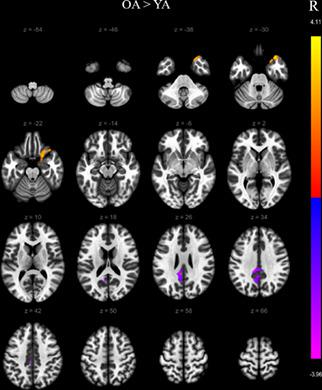当前位置:
X-MOL 学术
›
Hum. Brain Mapp.
›
论文详情
Our official English website, www.x-mol.net, welcomes your
feedback! (Note: you will need to create a separate account there.)
Age-related and individual variations in altered prefrontal and cerebellar connectivity associated with the tendency of developing internet addiction
Human Brain Mapping ( IF 3.5 ) Pub Date : 2021-06-25 , DOI: 10.1002/hbm.25562 Abhishek Uday Patil, Deepa Madathil, Chih-Mao Huang
Human Brain Mapping ( IF 3.5 ) Pub Date : 2021-06-25 , DOI: 10.1002/hbm.25562 Abhishek Uday Patil, Deepa Madathil, Chih-Mao Huang

|
Internet addiction refers to problematic patterns of internet use that continually alter the neural organization and brain networks that control impulsive behaviors and inhibitory functions. Individuals with elevated tendencies to develop internet addiction represent the transition between healthy and clinical conditions and may progress to behavioral addictive disorders. In this network neuroscience study, we used resting-state functional magnetic resonance imaging (rs-fMRI) to examine how and whether individual variations in the tendency of developing internet addiction rewire functional connectivity and diminish the amplitude of spontaneous low-frequency fluctuations in healthy brains. The influence of neurocognitive aging (aged over 60 years) on executive-cerebellar networks responsible for internet addictive behavior was also investigated. Our results revealed that individuals with an elevated tendency of developing internet addiction had disrupted executive-cerebellar networks but increased occipital-putamen connectivity, probably resulting from addiction-sensitive cognitive control processes and bottom-up sensory plasticity. Neurocognitive aging alleviated the effects of reduced mechanisms of prefrontal and cerebellar connectivity, suggesting age-related modulation of addiction-associated brain networks in response to compulsive internet use. Our findings highlight age-related and individual differences in altered functional connectivity and the brain networks of individuals at a high risk of developing internet addictive disorders. These results offer novel network-based preclinical markers of internet addictive behaviors for individuals of different ages.
中文翻译:

与发展网络成瘾趋势相关的前额叶和小脑连接改变的年龄相关和个体差异
网络成瘾是指有问题的网络使用模式,它不断改变控制冲动行为和抑制功能的神经组织和大脑网络。具有较高发展网络成瘾倾向的个体代表了健康和临床状况之间的过渡,并可能发展为行为成瘾障碍。在这项网络神经科学研究中,我们使用静息状态功能磁共振成像 (rs-fMRI) 来检查个体在发展网络成瘾的趋势中如何以及是否会重新连接功能连接并减少健康大脑中自发低频波动的幅度. 还研究了神经认知老化(60 岁以上)对负责网络成瘾行为的执行小脑网络的影响。我们的研究结果表明,网络成瘾倾向升高的个体破坏了执行小脑网络,但增加了枕壳-壳核连接,这可能是由于对成瘾敏感的认知控制过程和自下而上的感觉可塑性造成的。神经认知老化减轻了前额叶和小脑连接机制减少的影响,表明成瘾相关大脑网络的年龄相关调节是对强迫性互联网使用的反应。我们的研究结果强调了与年龄相关的个体差异,在功能连接的改变和个体的大脑网络中处于发展为网络成瘾疾病的高风险中。这些结果为不同年龄的个体提供了基于网络的新的网络成瘾行为临床前标记。
更新日期:2021-09-02
中文翻译:

与发展网络成瘾趋势相关的前额叶和小脑连接改变的年龄相关和个体差异
网络成瘾是指有问题的网络使用模式,它不断改变控制冲动行为和抑制功能的神经组织和大脑网络。具有较高发展网络成瘾倾向的个体代表了健康和临床状况之间的过渡,并可能发展为行为成瘾障碍。在这项网络神经科学研究中,我们使用静息状态功能磁共振成像 (rs-fMRI) 来检查个体在发展网络成瘾的趋势中如何以及是否会重新连接功能连接并减少健康大脑中自发低频波动的幅度. 还研究了神经认知老化(60 岁以上)对负责网络成瘾行为的执行小脑网络的影响。我们的研究结果表明,网络成瘾倾向升高的个体破坏了执行小脑网络,但增加了枕壳-壳核连接,这可能是由于对成瘾敏感的认知控制过程和自下而上的感觉可塑性造成的。神经认知老化减轻了前额叶和小脑连接机制减少的影响,表明成瘾相关大脑网络的年龄相关调节是对强迫性互联网使用的反应。我们的研究结果强调了与年龄相关的个体差异,在功能连接的改变和个体的大脑网络中处于发展为网络成瘾疾病的高风险中。这些结果为不同年龄的个体提供了基于网络的新的网络成瘾行为临床前标记。











































 京公网安备 11010802027423号
京公网安备 11010802027423号